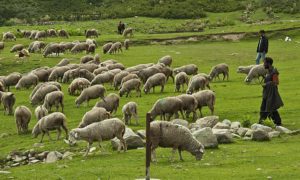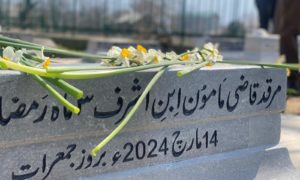Caste is the hereditary classification of society based on occupation, social status or economic position which distinguishes one group from the other. The most notable expression of caste is the Hindu caste system in India, which is the most correct example of how violent manifestations caste discrimination can assume.
The social system in Kashmir is delightfully plastic, observed Walter Lawrence in his book, Valley of Kashmir. He had used the term Kraam to denote caste.
T.N. Madan uses the word Zaath and says that it ‘points to birth’, similar to Jati among the Hindus. “The Kashmiris use the word Zaath in a broader sense, however, to connote essence or inherent nature. Used in the narrower sense, as a person’s surname for example, Zaath means either birth, e.g., Sayyid, Shaikh, or hereditary occupation, e.g., Khaar, Naevid, Guur,” concludes Madan.
Every society has its peculiar social order, and to attempt a generalised behavioural theory is not reasonable. Studies of the Muslim caste system in the subcontinent are subjective and need to be studied, taking into consideration the native social order, as Madan has cautioned. He advises against the temptation to treat Kashmiri social order as a ‘modified form of Muslim caste system’.
Continuity from the Past
The continuity of dominant castes’ privilege was ensured during the Dogra period when they rallied alongside the Pandits. A merger with Pakistan would have been their game, where they could have aligned with the Pakistani dominant castes/classes to maintain their power hegemony.
The ‘dubious accession’ with India upheld their privileged position alongside the Pandits until their population began downsizing, courtesy several migrations. Once the Pandits left, the court was all theirs and they became unchallenged masters of the social hierarchy in Kashmir.
It was not that the field was open for all, and the dominant castes made the most out of it, using talent and hardwork. The small number of Muslim kids attending schools during the Dogra period belonged to these families, and the Muslim committee formed after the Second Education Conference in 1915 to look into educational backwardness among Muslims, belonged to the same category. It was headed by the two Mirwaizes and Khwaja Hassan Shah Naqshbandi.
Foreign saints who rarely married in the valley became the carriers of these surnames. In the famous Abdulla Pandit example used by Lawrence, the delightfully plastic nature of social system in Kashmir can be gauged wherein it is easy to change surnames at will. He also notes that boatmen have adopted Dar and Dums have adopted Ganai as surnames for gaining respectability.
Classification
The dominant castes sit at the top by virtue of their lineage, which they trace back to the Prophet (PBUH), or saints who came to Kashmir from Central Asia. The occupational castes are the intermediate ones, followed by service castes, who form the despicable lot in the valley.
The general opinion seems to be that the Sayyids stand first in the hierarchy of Kashmir, says Lawrence. The Rishis, the Babas, and the Pirzadas are always looked upon as ‘pure Kashmiri’, and are called Wami, as distinguished from the Sayyids and the Pirzadas, who found their way to the valley from foreign countries. All these are connected with shrine-worship, and I think that their influence is far greater than that exercised by Mullahs in the mosque.
Thus among these castes also, a distinction is made between locals and those who came from outside. Lawrence busts the myth of distinction based on place of birth. “As compared with the Shekh Musalmans, the Sayyids may be regarded as foreigners, though there is practically nothing in their appearance, manners or language which distinguishes them from other Kashmiri Musalmans,” he writes.
The principle of proximity to the founder of Islam is the reason for their hegemony as argued by Madan. All other Muslims being local converts stood subordinated in the social hierarchy as compared to foreigners.
Social Mobility
Lawrence in his book further writes, “no respect is paid to descent. Wealth alone commands position, and poverty at once degrades a family.”
Interestingly Muslim caste is not as rigid as the Hindu caste. The dominant castes, who are a class of their own, don’t marry outside their caste. Among the rest though, an increase in economic standards results in caste mobility. A dominated caste person getting employed is liable to receive better social recognition and matrimonial opportunities.
Caste exhibits special dynamics along with class though both are independent constructs. Mostly dominant castes, by virtue of their access to better opportunities, go on to become the dominant class as well. Caste-class nexus becomes an inherent social fact of Kashmiri society. Walter Lawrence thus notes, “the safed posh class of villagers, that is the more affluent men, who wear white clothes, do not work, but look on while others toil. They have a better kind of house and often have excellent gardens and good orchards… They pay frequent visits to the city, and are usually connected in marriage with Srinagar families.”
This caste mobility is a consequence of what M.N. Srinivas, the famous Indian sociologist, called Sanskritisation, that is, dominated castes imitating the practices and behaviour of dominant castes. In Kashmiri Muslims, caste mobility is possible and results in absolute gains in social standing though relatively not much change is observed.
Nonetheless an upliftment in economic conditions never means that the social label of caste will be cut off from a person’s name and social position. A guur remains a guur even if he becomes a well established officer in any government sector. A khaar remains a khaar even if his business scales enough monetary heights. Madan clarifies, though there has long been evidence of upward mobility among Muslim occupational groups, I doubt if the Domb and Vaatal could easily live down the stigma of their names, which proclaim their Zaath.
About the dominated castes, Madan, who called them Naangaars, that is, landless, has this to say: The various Naangaar groups, however, are characterized by a low degree of occupational mobility and a high incidence of endogamous marriages.
Casteist Composition in KU and IUST
A preliminary research about the composition of faculty in Kashmir University and Islamic University of Science and Technology revealed some important information regarding the proportion of dominant caste members in these two institutions.
The academic structure of Kashmir University consists of 12 faculties, 47 departments and 21 centres. Going by the composition according to the university prospectus, the total number of teaching faculty members is 370 out of which 94 belong to dominant castes. Pertinently surnames were found missing in many cases. However, as expected, members of dominant castes have not missed displaying their surnames.
Among the professors who supervise 11 schools, four belong to dominant castes, the schools being Applied Sciences & Technology, Education & Behavioural Sciences, Biological Sciences and Physical & Mathematical Sciences. The Dean Research is a dominant caste member, too.
Officers in the administration department are 19 in number and 10 are from dominant castes. The Director of Information Technology & Support Systems is a dominant caste member while among six library officials, two are from dominant castes. The Provost and Warden of one boys’ hostel are dominant caste members.
There is one person, a dominant caste professor, who occupies three posts simultaneously. He primarily heads the Department of Central Asian Studies while acting as Dean Department of Social Welfare as well as the Provost.
Of the 47 departments, only seven are such where none of the faculty member is from any dominant caste. Going through the non-teaching staff of different departments, it was interesting to note that not one dominant caste person occupied any position which usually comprises of clerical and manual staffers.
Islamic University of Science & Technology, a private university, essentially caters to the dominant class as the volume of fees to be paid is too high and unaffordable for non-dominated class youth. It vividly represents the dominant class and dominant caste dynamic with the former more apparent.
12% of the teaching staff is from dominant castes. The university has a teaching faculty strength of 233 among whom 28 belong to dominant castes. Two of the five schools are headed by dominant caste professors.
Given the miniscule portion of Kashmiri population that dominant castes are, their percentage of 12% in IUST and 25% in KU reveals that they form an important proportion in our higher education system.
The Road Ahead
The purpose of this above exercise is to demonstrate one arena where priori privilege of dominant caste helps them secure maximum social capital. A similar observation can be found in the ownership of means of production or propagation of indigenous culture. The latter is subject to hegemonic interpretations of dominant castes which steer the whole society.
Caste in Kashmir acts as a social discriminatory tool. It is a slur that tarnishes the dignity and respect of those dominated. They are made to feel like lesser humans. A saying like: “if you encounter a Gujjar and a snake on a bridge, kill the former first” would obviously do no good to the community’s existence as social beings. It violates their inherent right to be “treated as equals”.
Add to this the fact that the segregation on caste lines still exists. Dominant castes by virtue of their pre-existing privileges have secured a better future for their next generations while as the dominated castes continue to remain stuck to their “undignified” occupations. This further ceases the “equal treatment” of individuals.
Dominant castes occupy high rung offices in the state administration. In the resistance camp as well, one struggles to find as many number of dominant caste people participating in direct political action, with their lives and property.
Nevertheless dominated castes have increasingly fared well in improving their educational conditions — a reason why pervasive caste discrimination has been improbable. Grees are no longer the illiterate and uneducated lot. The educational upliftment therefore fundamentally questions and challenges the hegemonic social structure.
Caste, a categorisation which makes the (dominated castes of) society readily susceptible for exploitation, should be done away with in an age characterised by rationality based modernity.
Rouf Dar is a Political Science student at University of Kashmir.
Views and opinions expressed in this article are those of the author’s and do not necessarily reflect the editorial position and policy of Free Press Kashmir.
Like this story? Producing quality journalism costs. Make a Donation & help keep our work going.








